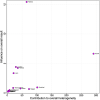Osteocalcin serum concentrations and markers of energetic metabolism in pediatric patients. Systematic review and metanalysis
- PMID: 36714656
- PMCID: PMC9878130
- DOI: 10.3389/fped.2022.1075738
Osteocalcin serum concentrations and markers of energetic metabolism in pediatric patients. Systematic review and metanalysis
Abstract
Background: Osteocalcin plays a role in glucose metabolism in mice, but its relevance in human energetic metabolism is controversial. Its relationship with markers of energetic metabolism in the pediatric population has not been systematically addressed in infants and adolescents.
Objective: This study aims to assess the mean differences between tOC, ucOC, and cOC among healthy children and children with type 1 or type 2 diabetes (T1D or T2D) and the correlation of these bone molecules with metabolic markers.
Methods: A systematic review and metanalysis were performed following PRISMA criteria to identify relevant observational studies published in English and Spanish using PubMed, Scopus, EBSCO, and Web of Science databases. The risk of bias was assessed using New Castle-Ottawa scale. Effect size measures comprised standardized mean difference (SMD) and Pearson correlations. Heterogeneity and meta-regressions were performed.
Results: The 20 studies included were of high quality and comprised 3,000 pediatric patients who underwent tOC, cOC, or ucOC measurements. Among healthy subjects, there was a positive correlation of ucOC with WC and weight, a positive correlation of tOC with FPG, HDL-c, WC, height, and weight, and a negative correlation between tOC and HbA1c. Among diabetic subjects, a negative correlation of ucOC with HbA1c and glycemia in both T1D and T2D was found and a negative correlation between tOC and HbA1c in T1D but not in T2D. The ucOC concentrations were lower in T2D, T1D, and patients with abnormal glucose status than among controls. The serum concentrations of tOC concentrations were lower among T1D than in controls. The patient's age, altitude, and HbA1c influenced the levels of serum tOC.
Conclusion: Osteocalcin is involved in energy metabolism in pediatric subjects because it is consistently related to metabolic and anthropometric parameters.
Systematic review registration: https://www.crd.york.ac.uk/prospero/, identifier: CRD42019138283.
Keywords: energetic metabolism; glucose - insulin; osteocalcin; pediatric patient; systematic review & meta-analysis.
© 2023 Villafan Bernal, Rodríguez-Narciso, Martinez-Portilla, Careaga-Cárdenas, Rubio-Navarro, Barba Gallardo and Delgadillo-Castañeda.
Conflict of interest statement
The authors declare that the research was conducted in the absence of any commercial or financial relationships that could be construed as a potential conflict of interest.
Figures






References
-
- Díaz-López A, Bulló M, Juanola-Falgarona M, Martínez-González MA, Estruch R, Covas MI, et al. Reduced serum concentrations of carboxylated and undercarboxylated osteocalcin are associated with risk of developing type 2 diabetes mellitus in a high cardiovascular risk population: a nested case-control study. J Clin Endocrinol Metab. (2013) 98(11):4524–31. 10.1210/jc.2013-2472 - DOI - PubMed
-
- Villafán-Bernal JR, Llamas-Covarrubias MA, Muñoz-Valle JF, Rivera-León EA, González-Hita ME, Bastidas-Ramírez BE, et al. A cut-point value of uncarboxylated to carboxylated Index is associated with glycemic Status markers in type 2 diabetes. J Invest Med. (2016) 62(1):33–6. 10.2310/JIM.0000000000000015 - DOI - PubMed
-
- Sanchez-Enriquez S, Ballesteros-Gonzalez IT, Villafán-Bernal JR, Pascoe-Gonzalez S, Rivera-Leon EA, Bastidas-Ramirez BE, et al. Serum levels of undercarboxylated osteocalcin are related to cardiovascular risk factors in patients with type 2 diabetes mellitus and healthy subjects. World J Diabetes. (2017) 8(1):11. 10.4239/wjd.v8.i1.11 - DOI - PMC - PubMed
Publication types
LinkOut - more resources
Full Text Sources

